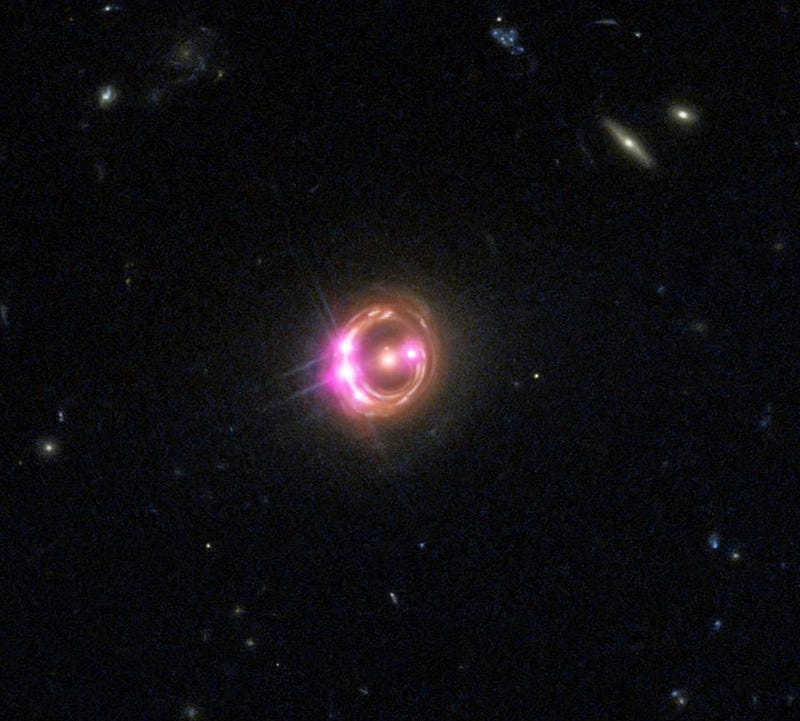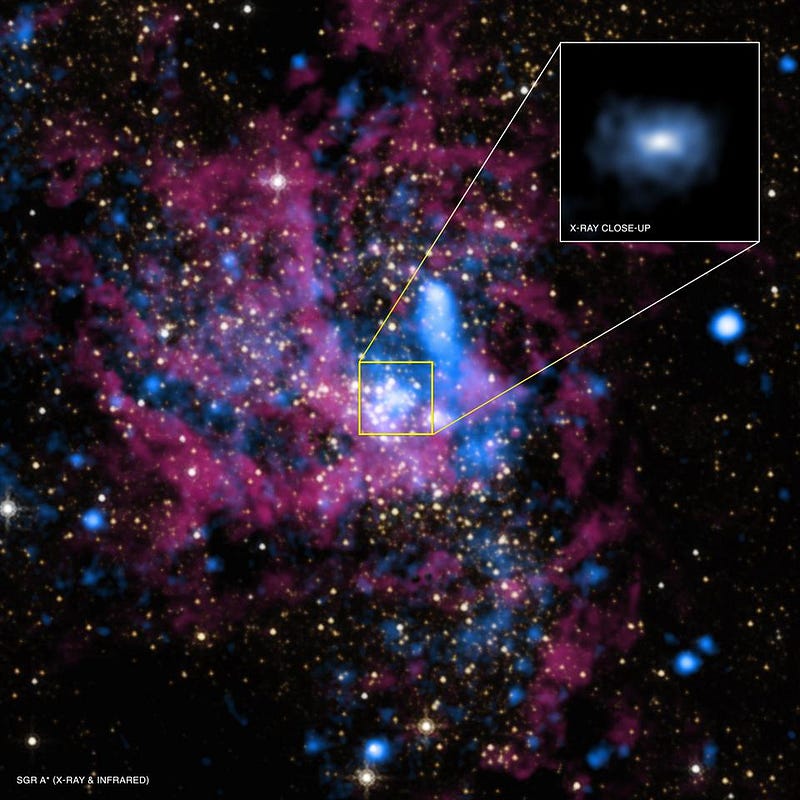The Incredible Science Behind Black Holes, Gravity, And The 2020 Nobel Prize

Congratulations to Penrose, Ghez and Genzel, and to black hole enthusiasts everywhere.
On October 6, 2020, the Nobel Prize in Physics was awarded towards research in black holes. 50% of the prize went to Roger Penrose for theoretical work demonstrating how black holes could physically, realistically form in our Universe, while 50% went jointly to Andrea Ghez and Reinhard Genzel for the discovery of Sagittarius A*: generally accepted to be a supermassive black hole at the center of our Milky Way. These three prize recipients are absolutely deserving for the incredible research work they’ve done, and marks the first Nobel Prize ever for what many scientists consider pure gravitational research.
Albert Einstein never won a Nobel Prize for General Relativity, and he himself thought that black holes were purely mathematical creations, not actual, physical objects. Penrose’s theoretical work was critical in not only rigorously providing a pathway for their formation, but in revolutionizing how physicists think about these spacetimes. Similarly, Ghez and Genzel transformed the field of observational astronomy, particularly of objects near the galactic center, enabling us to learn more about black holes than ever before. Here’s the science behind the Nobel Prize in Physics for 2020: for black holes.

When Einstein first put forth General Relativity in 1915, it was both a triumph and a test for science: could this new idea truly supersede and replace Newton’s theory of gravity? This revolutionary conception did away with ideas such as:
- gravity was an instantaneous force, replacing it with the notion that it propagated at the speed of light,
- that space and time were absolute, fixed, unchanging quantities, replacing them with a unified spacetime fabric,
- that the shortest distance between two points was a straight line, instead replacing it with the idea of geodesics (world-lines) and spacelike, timelike, and null (light-like) paths,
while introducing a novel relationship between matter-and-energy, on one hand, and the fabric of spacetime on the other hand. Just a few months after Einstein introduced his theory, the first exact, nontrivial solution was found: for a non-rotating black hole.

Karl Schwarzschild’s 1916 solution was the first mathematical formulation to describe an event horizon in General Relativity, but Einstein didn’t think that these objects could physically exist. For a long time, research on this front didn’t progress much, as few researchers took interest in this aspect of physics. However, in the early 1960s — shortly after Einstein’s death — a number of aspects of General Relativity came back to the forefront. Spurred on by the original work of scientists like Bob Dicke and John Wheeler, young researchers at the time began to investigate some of the more esoteric aspects of General Relativity.
While some — like 2017 Nobel Laureate Kip Thorne — worked on the science of gravitational waves or — like 2019 Nobel Laureate Jim Peebles — worked on cosmology, others focused on the most extreme gravitational systems of all: black holes. One of the early, important theoretical discoveries was that if you started with a system of masses and allowed them to gravitationally collapse, so long as there was nothing to counteract that collapse (like radiation or degeneracy pressure), you would inevitably form a black hole.

These “singularity theorems,” as they’re known today, were some of the early work that both Roger Penrose and the recently deceased Stephen Hawking were renowned for. But Penrose himself — on his own — did something even more profound. He described in a rigorous fashion, for the first time, how a physical system of matter that wasn’t a black hole could collapse into one: forming both a singularity and an event horizon around it. In particular, he also conceptualized the light-paths that would emerge from every point under consideration, throughout all of space at all times.
What would be swallowed by the black hole? Where was the border between what could or couldn’t escape? And how did spacetime itself behave inside, outside, and on the border of the event horizon?
Penrose not only asked and answered these questions in his landmark 1965 paper, but came up with a way of visualizing the entire spacetime in a simple two-dimensional representation: Penrose diagrams. Practically every physicist under the age of 60 who’s learned General Relativity has, at some point, been a beneficiary of the tremendous theoretical brilliance and heavy lifting done by Penrose during this era.

Of course, there’s also extraordinary observational work that goes hand-in-hand with the theoretical breakthroughs that occurred surrounding black holes. In the 1960s, the first quasars were discovered: quasi-stellar radio sources (QSRS), which were soon discovered to also have X-ray emissions. While debates raged for years over what these objects were, they were quite consistent with being enormous, supermassive black holes that had sunk to the centers of galaxies. The dream became to measure them directly, and to determine exactly what their properties were.
X-ray emissions revealed binary black hole systems — where stars orbiting around black holes provided accreted matter for black holes to accelerate and heat up, causing the emission of X-rays — while radio waves revealed pulsars dancing together, enabling orbital decay tests of General Relativity. But the supermassive black holes remained elusive, with only the indirect radio and X-ray emissions revealing them.

That’s where the remarkable work of scientists like Andrea Ghez and Reinhard Genzel came in. Using longer-wavelength observations than the human eye could see and combining that data with atmospheric correction technologies — such as speckle interferometry and adaptive optics — allowed us to measure the positions of stars many thousands of light-years away to high precision. What’s even more remarkable is that we could do it in the galactic center: a region of space obscured by light-blocking matter along the line-of-sight.
If you look up at the Milky Way on a clear night under dark conditions, you’ll see not only the white glow of billions of unresolved stars, but also these dark clouds: the dust lanes of the Milky Way. These clouds are very efficient at blocking visible light, but the small dust grains have a harder time with longer wavelength light. As we move into the infrared and radio ranges of light, the light from stars even 26,000 light-years away, orbiting the galactic center, can be seen.

Genzel was a pivotal figure in the adaptive optics design and construction for the European Southern Observatory, while Ghez was perhaps the most influential person in this field using the W.M. Keck Observatories in Hawaii. Both scientists began observing and tracking individual stars orbiting the galactic center in the 1990s, and the number of stars, the orbital details, and the stellar trajectories have only improved over the past 20+ years.
These orbits reveal that the stars all orbit one single point, as though a very massive object were dominating the gravitational field in this region of space, similar to how our Sun gravitationally dominates the orbits of planets in our Solar System. Yet that point, which is not only theoretically well-defined, but coincides with the source the largest flux of X-ray flares in our galaxy, emits no visible or infrared light at all. It’s completely dark, excepting the flares, and requires a mass of millions of solar masses.

The project to track and measure the orbital parameters of these stars have revealed a number of important properties about our galactic center. In particular, we’ve learned the following.
- The stellar orbits all point towards a mass of ~4 million solar masses for the galaxy’s central black hole, a value that’s 50% larger than the masses inferred from (model-dependent) X-ray emissions.
- The stars that make very close approaches to the event horizon provide the best tests of both Special and General Relativity, as they reach speeds of a few percent the speed of light. The data favors Einstein, disagrees with Newton, and significantly constrains alternatives to General Relativity.
- And many purely relativistic effects, including gravitational redshift and gravitational time dilation, have been observed in the data concerning these stars.
Just a few months ago, a new set of stars that move faster and get closer to the black hole at our galaxy’s center were discovered, providing a new astrophysical laboratory to test General Relativity under even more extreme conditions.

While Penrose, Ghez, and Genzel are all incredibly deserving of this Nobel Prize, the self-imposed three person limit on Nobel Laureates ensures that many worthy contributors to our knowledge about black holes were omitted from this award. A few that you should know include:
- Roy Kerr, whose 1963 paper on black holes provided the exact solution for a black hole that has both mass and angular momentum: a (much more realistic) rotating black hole.
- Andreas Eckart, an active scientist who was arguably just as important to the science of stars orbiting in the galactic center as Genzel or Ghez.
- Everyone associated with the Event Horizon Telescope, which directly imaged a black hole’s event horizon for the first time (at the center of the galaxy M87) and famously released the image last year.
- And Stephen Hawking, whose work on singularities and black holes in General Relativity rival Penrose’s in importance, but who cannot be awarded a Nobel any longer, as there are no posthumous Nobel awards.

As deserving as the three Nobel Laureates are this year, many unheralded scientists laid the groundwork for these discoveries, participated in doing the overwhelming majority of the hard work that only a few people will get the credit and accolades for, and are working to extend and continue the foundational work that was laid by this year’s crop of winners. Additionally, the majority of Penrose’s most influential work occurred in the 1960s and 1970s; his work from the 1980s onward is frequently much more disputed, controversial and speculative, although no less imaginative than his landmark, Nobel-winning research.
But the most incredible fact is this: we can effectively “weigh” absolutely any object in the Universe, including one that’s completely dark or even invisible, just by measuring the light from the objects that orbit it over time. When we measure the light precisely enough, we can even infer the full three-dimensional motions of these objects, revealing the gravitational mass that’s anchoring them, and testing the governing law of gravity at the same time. For 2020, let’s join the world in celebrating black holes and three of the scientists — Penrose, Ghez, and Genzel — who helped unveil the scientific truth behind these cosmic extremophiles!
Starts With A Bang is written by Ethan Siegel, Ph.D., author of Beyond The Galaxy, and Treknology: The Science of Star Trek from Tricorders to Warp Drive.





